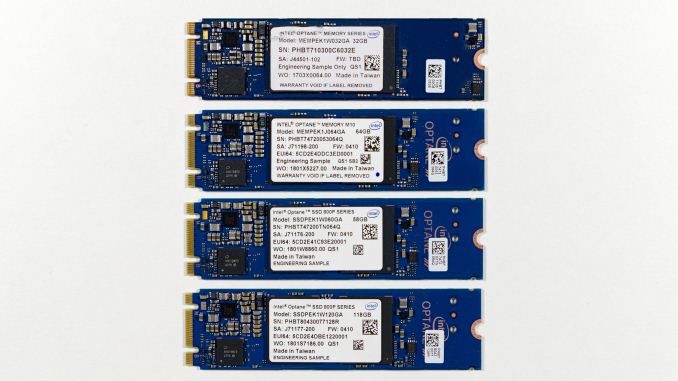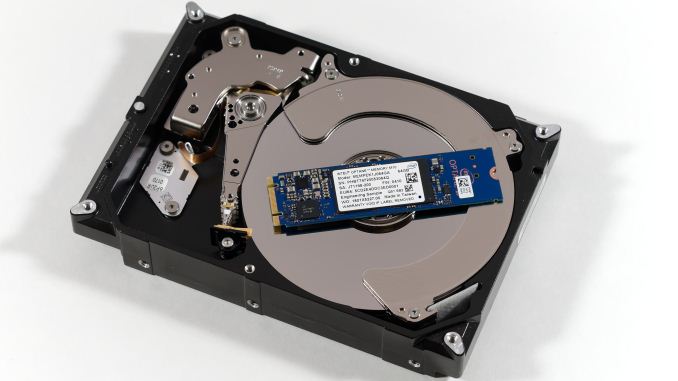The Intel Optane Memory M10 (64GB) Review: Optane Caching Refreshed
by Billy Tallis on May 15, 2018 10:45 AM EST- Posted in
- SSDs
- Storage
- Intel
- PCIe SSD
- SSD Caching
- M.2
- NVMe
- Optane
- Optane Memory
Conclusion: Going for a Data Cache
At the hardware level, the Optane Memory M10 is a simple and straightforward update to the original Optane Memory, bringing a new capacity that some users will appreciate, and power management that was sorely lacking from the original. On the software side, the experience is quite similar to the first iteration of Optane Caching that Intel released a year ago with their Kaby Lake platform. The only big user-visible change is the ability to cache non-boot drives. This corrects the other glaring omission, giving the Optane Memory system an overall impression of being a more mature product that Intel is taking seriously.
Optane Memory caching now seems to be limited primarily by the fundamental nature of SSD caching: not everything can fit in the cache. Occasional drops down to hard drive performance are more frequent and more noticeable than when a flash-based SSD's SLC write cache fills up, or when a M.2 SSD starts thermally throttling. Neither of those happens very often for real-world use, but cache misses are still inevitable.
The latency from a flash-based SSD tends to grow steadily as the workload gets more intense, up to the point that there isn't enough idle time for garbage collection. The performance of most modern flash-based SSDs degrades gracefully until the SLC cache fills up. The latency distribution from an Optane+hard drive cache setup looks very different: latency is excellent until you try to read the wrong block, then you have to wait just as long as in a hard drive-only setup.
The key to making SSD caching work well for desktop use is thus to ensure that the cache is big enough for the workload. For relatively light workloads, the 32GB Optane Memory is often sufficient, and even the $25 16GB module that we haven't tested should offer a noticeable improvement in system responsiveness. For users with heavier workloads, the larger 64GB Optane Memory M10 and even the 118GB Optane SSD 800P may not be big enough, and the price starts getting close to that of a good and reasonably large SATA SSD.
For power users, the data drive acceleration mode is more appealing. A gamer might want to use a 256GB or 512GB SATA SSD for the OS and most programs and documents, but would need a 1TB or larger drive for his entire Steam library. A 1TB 7200RPM hard drive plus the 64GB Optane Memory M10 or the 58GB Optane SSD 800P is cheaper than a good 1TB SATA SSD, and the cache is large enough to hold one or two games. A 2TB hard drive plus the 118GB Optane SSD 800P can cache the even the largest of AAA games and is no more expensive than the cheapest 2TB SATA drive. For capacities beyond that, caching only gets more appealing.
Our SYSmark testing showed that for many common tasks, adding even a 32GB cache to a hard drive can bring performance up to the level of a SSD-only configuration. There are a lot of lightweight everyday workloads that can fit well in such a cache, and for those users the larger 64GB Optane Memory M10 doesn't bring worthwhile performance improvements over the 32GB Optane Memory.
On the other hand, it is clear that no amount of fast storage can make up for a system crippled by too little RAM, which is a disappointment in a time when SSDs are getting cheaper but RAM prices are still climbing. Optane SSDs may be the fastest swap devices money can buy, but they're no substitute for having adequate RAM. The 4GB low-end configuration we tested is simply not enough anymore, and for future storage caching tests we will consider 8GB as the absolute minimum requirement before any storage performance upgrades should be considered.
Our synthetic benchmarks of Intel's Optane Memory caching confirmed the most predictable effects of cache size compared to working set size, but didn't reveal many nuances of Intel's cache management strategies. There is clearly some overhead relative to accessing just the SSD, but not enough eliminate the fundamental performance advantages of 3D XPoint memory. There also appears to be some write caching and combining done with system RAM, trading a bit of safety for improved write performance beyond even what the Optane SSDs alone can handle. Whether it's advertised or not, this tends to be a feature of almost every third-party add-on software for storage acceleration. It's the simplest way to improve storage benchmark numbers and the tradeoffs are quite acceptable to many users.
The Optane Memory caching seems to be quite responsive to changes in usage patterns. One launch of an application is sufficient to bring its data into the cache, and Intel isn't shy about sending writes to the cache. It doesn't appear that the Optane Memory caching system does anything significant to reduce wear on the cache device, so Intel seems confident that these cache devices have plenty of write endurance.
| Intel Optane Product Lineup | |
| Capacity | Drives |
| 16 GB | Optane Memory (M.2) $24.99 ($1.56/GB) |
| 32 GB | Optane Memory (M.2) $58.91 ($1.84GB) |
| 58 GB 64 GB |
Optane SSD 800P (M.2) $111.48 ($1.92/GB) Optane Memory M10 $144 ($2.48/GB) |
| 118 GB | Optane SSD 800P (M.2) $196.43 ($1.66/GB) |
| 280 GB | Optane SSD 900P (AIC, U.2) $354.99 ($1.27GB) |
| 480 GB | Optane SSD 900P (AIC) 544.99 ($1.14/GB) Optane SSD 905P (U.2) $599.00 ($1.25/GB) |
| 960 GB | Optane SSD 905P (AIC) $1299.00 ($1.35/GB) |
Intel's 3D XPoint memory is clearly a far better media for small cache drives than NAND flash, but it is still afflicted by a very high price per GB. Only the 16GB Optane Memory at $25 seems like an easy purchase to make, but it is small enough that its performance potential is much more limited than the larger Optane products. The 64GB Optane Memory M10 is expensive enough that skipping caching altogether and going with just a SATA SSD has to be seriously considered, even when shopping for 1 or 2 TB of storage. In spite of the power management the Optane Memory M10 adds over the original cache module, it still doesn't seem like a hard drive plus a cache module makes any sense for mobile use. Optane prices need to come down faster than NAND prices in order for this caching strategy to gain wide acceptance. This doesn't seem likely to happen, so Optane Memory will remain a niche solution—but that niche is definitely not as small as it was when Optane Memory was first introduced.












96 Comments
View All Comments
FunBunny2 - Wednesday, May 16, 2018 - link
one of the distinguishing points, so to speak, of XPoint is its byte-addressable protocol. but I've found nothing about the advantages, or whether (it seems so) OS has to be (heavily?) modified to support such files. anyone know?Billy Tallis - Wednesday, May 16, 2018 - link
The byte-addressability doesn't provide any direct advantages when the memory is put behind a block-oriented storage protocol like NVMe. But it does simplify the internal management the SSD needs to do, because modifying a chunk of data doesn't require re-writing other stuff that isn't changing. NVDIMMs will provide a more direct interface to 3D XPoint, and that's where the OS and applications need to be heavily modified.zodiacfml - Friday, May 18, 2018 - link
Quite impressive but for 32GB Optane drive, I can have a 250 GB SSD.The Optane might improve performance for fractions of a second over SSDs for applications but it won't help during program/driver installations or Windows updates which needs more speed.
I'd reconsider it for a 64 GB Optane as a boot drive for the current price of the 32GB.
RagnarAntonisen - Sunday, May 20, 2018 - link
You've got to feel for Intel. They spend a tonne of cash on projects like Larrabee, Itanium and Optane and the market and tech reviewers mostly respond with a shrug.And then everyone complains they're being complacent when it comes to CPU design. Mind you they clearly were - CPU performances increased at a glacial rate until AMD released a competitive product and then there was a big jump from 4 cores to 6 in mainstream CPUs with Coffee Lake. Still if the competition was so far behind you can afford to direct to R&D dollars to other areas.
Still it all seems a bit unfair - Intel get criticised when they try something new and when they don't.
And Itanium, Larrabee and Optane all looked like good ideas on paper. It was only when they had a product that it became clear that it wasn't competitive.
Adramtech - Sunday, May 20, 2018 - link
since when is a 1st or 2nd Gen product competitive? I'm sure if they don't have a path to reach competitiveness, the project will be scrapped.Keljian - Tuesday, May 29, 2018 - link
While I don't doubt the tests are valid, I would really like to see a test with say PrimoCache - with the blocksize set to 4k. I have found in my own testing that Optane (with PrimoCache using optane as an L2 @ 4k) is very worthwhile even for my Samsung 950 pro.Keljian - Tuesday, May 29, 2018 - link
https://hardforum.com/threads/intel-900p-optane-wo... - Here are my benchmark findings for the 850 evo and 950 pro using the 32gb optane as L2 cache. You'll notice the 4k speeds stand out.denywinarto - Tuesday, May 29, 2018 - link
Thinking of using this with 12 tb hgst for a gamedisk drive for a ISCSI-based server, the data read is usually the same as they only game files. But occasionally new game gets added. Would it be a better option compared to raid? SSD are too expensive.Lolimaster - Monday, October 1, 2018 - link
Nice to use the 16GB as pagefile, chrome/firefox profile/cacheLolimaster - Tuesday, October 2, 2018 - link
It's better to use them as extra ram/pagefile or scratch disk.